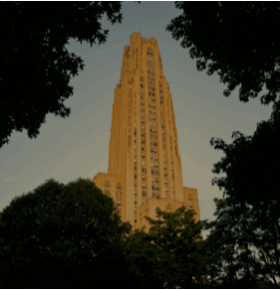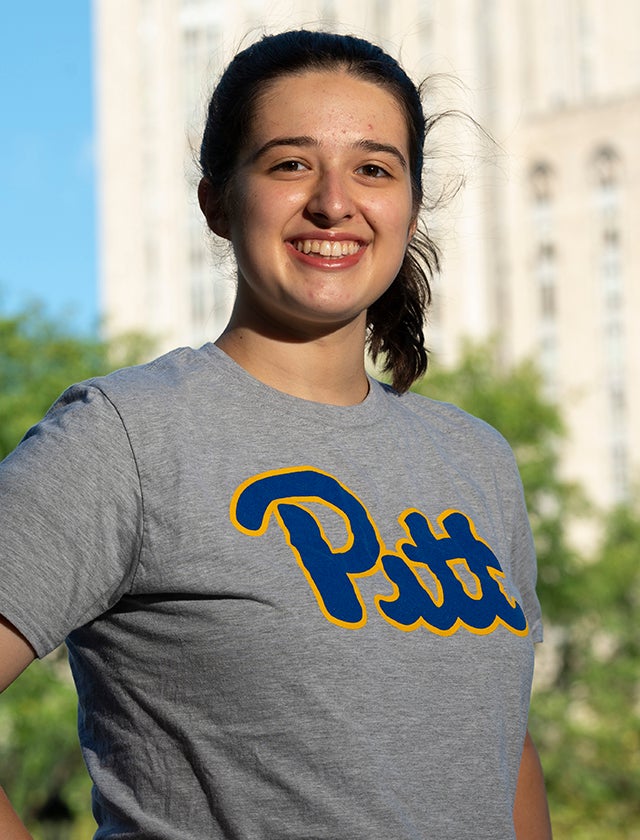
Subscribe to Pittwire Today
Get the most interesting and important stories from the University of Pittsburgh.This nationally lauded scholar is helping Spanish speakers learn complex science.
Catherine Cavanaugh was in her basement studying physics the morning she was invited to apply to be a U.S. Presidential Scholar. She initially thought the note was a scam, but some quick research confirmed that she was indeed tapped for one of the most prestigious awards for high school seniors. She applied and, a few months later, learned she won.
Cavanaugh is one of 161 students in the 57th class of Presidential Scholars — and one of two Presidential Scholars currently attending Pitt. Both students were featured in a video shared by the Secretary of Education Miguel Cardona and are in Pitt’s University Honors College.
“Catherine is an extraordinarily accomplished student and is extremely deserving of recognition as a Presidential Scholar,” said Nicola Foote, dean of the Honors College. “Her work creating tools for ESL students to learn STEM subjects effectively has made a truly transformative impact, and her leadership has seeded the success of others. She exemplifies all of the values of the University Honors College, and I am so proud of her.”
The first-year neuroscience major in the Kenneth P. Dietrich School of Arts and Sciences and Lansdale, Pennsylvania, native was also chosen as a National Honor Society finalist out of 10,000 applicants.
Cavanaugh began applying for scholarships during her first year at North Penn High School and applied for more than 50 to ensure she could attend her first-choice institution — the University of Pittsburgh.
“I knew I had to work hard to come to Pitt,” she said.
Despite receiving national recognition and various prestigious awards, those she didn’t win have positively informed her outlook as well.
“It built character,” she said. “When I later received accolades, I never felt I did because I was better than someone else but because the people reviewing my resume or work connected with me on a deeper level and saw something they wanted to tap into.”
Cavanaugh is fluent in Spanish and began honing her language skills at age two with lessons. Her passion only grew with encouragement from her Nicaraguan aunt, parents and instructors throughout her K-12 education. Though her parents don't speak Spanish, “They always thought it important to have an appreciation for languages and cultures,” she said.
These experiences and hearing stories about her grandfather, who only spoke Italian until age five, gave her firsthand knowledge of language barriers and challenges they present.
As a peer tutor and Spanish Honor Society president in high school, she soon discovered disturbing patterns among English as a Second Language (ESL) students.
“Lots of students needed help,” said Cavanaugh. “Almost every ESL kid was coming in with questions about content areas I’d struggled to understand at certain points, even as a native English speaker. There wasn’t much support in the system.”
So, she took the issue to the superintendent and requested $200 to purchase one Spanish health textbook. Citing limited resources and bandwidth, the superintendent denied the request. But Cavanaugh wasn’t derailed.
“I felt close to these students and in talking to them, found out many were working one or two jobs, taking care of younger siblings and not only trying to understand the educational content but also understand the language the content was taught in.”
When COVID-19 and virtual learning hit, she saw that it created even more hurdles for these students. In response, she launched the Spanish Translation Project (STP), a website offering translated educational content for generally difficult subjects like health, biology and chemistry. With help from teachers and friends (some now Panthers themselves), Cavanaugh formed a peer tutor team of 15 and created PowerPoints that provided a year’s worth of curriculum to ESL students for free. Schools in five different countries and 20 states across the U.S., including Pennsylvania, now use the program.
With her first semester at Pitt nearly completed, Cavanaugh's goal is to expand STP to honor and acknowledge her grandfather's struggles and those of ESL students. This year, she wants to add American government, marine biology and possibly recorded math lectures to STP’s site.
Outside of STP, she’s keen to explore Pitt’s academic offerings, specifically those related to language and neurological developmental diseases — “anything dealing with linguistic impairment, especially Alzheimer's disease.”
On a free day, Cavanaugh can be found enjoying Pittsburgh's arts and culture and bolstering her Italian skills. Mondays are for Italian card games, Thursdays consist of lunch with Italian club members, and weekly, she attends Italian film screenings at the Frick Fine Arts Building. And as a cellist, she's already been to the symphony and intends to bring her cello, nicknamed Eleanor, to campus next semester.
"It's a phenomenally supportive community and so collaborative. That's what I love about the University."



